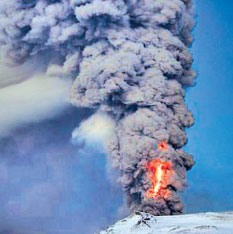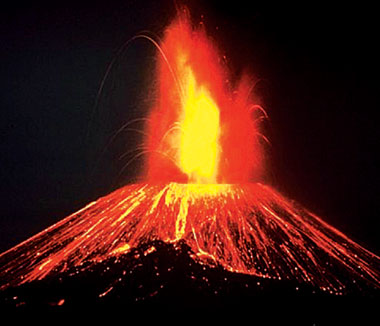Is Katla about to erupt?
The world is being battered by nature.... Today many parts
of the world are facing Mother Nature's fury. Natural disasters are
ravaging so many countries and things are only going to get worse in the
future, especially if we continue to pollute the atmosphere and destroy
the environment.
The extreme weather conditions experienced throughout the world
including our country are a direct result of global warming.
|

Katla is one of the largest volcanoes in Iceland |
However, all disasters are not caused as a direct result of man's
careless actions.
Volcanic eruptions are one such disaster and today we like to focus
your attention on this topic because volcanic activity around the world
is on the increase with scientists warning of a possibility of yet
another volcano in Iceland erupting soon.
Remember how much chaos was caused when one of Iceland's volcanoes
with the jaw breaking name Eyjafjallajokul erupted last year disrupting
air traffic in Europe? Now once again seismologists claim there is a
threat of one of Iceland's largest volcanoes erupting leading to far
worse results .

Katla, one of the two biggest volcanoes in Iceland(with the strato-volcano
Hekla being the other) is showing signs of eruption - a long overdue
eruption that could be devastating according to seismologists.
With clusters of small earthquakes being detected around Katla as
recently as last week they claim an eruption could be imminent as the
earthquakes have been growing in strength too.
After a long period of magnitude 3 tremors, a magnitude 4 quake was
detected last week.
While Katla rumbles with earthquakes the seismologists are closely
monitoring the activities around it ..So let's check out some
interesting facts about Katla and volcanoes today ...
If Katla erupts....
If Katla Volcano awakens from slumber and erupts, it will not only be
the Icelanders and air travelers who are affected. Eruptions from the
large volcanoes have wreaked havoc on the Earth's ecosystem by lowering
temperatures and thinning the ozone layer.
Gases released in a major eruption can cause increased coughing and
eye and skin irritation that can lead to serious lung conditions. Ash
which has sharp, jagged edges microscopically can get into lungs and
airways and cause health conditions.
Another global effect of a volcanic eruption is a cool down in
temperatures. Sulfur released from volcanic eruptions can cool the
Earth.
Sulfur can form sulfuric acid droplets that can block the sunlight
hitting the Earth. These sulfur infused droplets that can stay in the
atmosphere for a year.
Another Iceland volcano, Laki erupted in 1783 and caused extreme
weather in Europe and contributed to a rise in respiratory diseases.
If Katla erupts it can cause temperatures to fall worldwide. However,
an eruption of Katla's magnitude could unintentionally have positive
effects such as slowing global warming.
Katla, a deadly
volcano
The home of the Katla volcano is the southernmost glacier
Myrdalsjokull glacier which is the fourth biggest in Iceland. It covers
the upper part of a large volcano, the Katla caldera which is 10 km in
diametre, and is covered with 200-700 metres (660-2,300 ft) of ice. The
highest points of the ice cap lie on the caldera. Within the caldera the
ice is hundreds of metres thick.
The subglacial volcano Katla has a reputation of being one the most
dangerous volcanoes of Iceland. Its peak reaches 1493 m in height and
the extension of the glacier which lies over it reaches 595 km2.
Twenty eruptions have been documented between 930 and 1918 at
intervals of 13-95 years. It has not significantly erupted for 93 years,
although there may have been small eruptions that did not break the ice
cover in 1955 and 1999. The name Katla is derived from the word ketill
(kettle) referring to the form of the volcano.
What is a volcano?
* A volcano is a landform (usually a mountain) where molten rock
erupts through the surface of the planet Earth. It is in fact a mountain
that opens downward to a pool of molten rock (magma) below the surface
of the Earth.
* The name volcano has its origin from the name of Vulcan,the God of
fire in Roman mythology.
*Magma is the liquid rock inside a volcano and lava is the liquid
rock (magma) that flows out of a volcano.
*The Earth's crust is made up of huge slabs called plates, which fit
together like a jigsaw puzzle. These plates sometimes move.Between the
Earth's crust and the mantle is a substance called magma which is made
of rock and gases.When two plates collide, one section slides on top of
the other, the one beneath is pushed down. Magma is squeezed up between
two plates.
*There are around 1510 'active' volcanoes in the worldwith f 80 or
more which are under the oceans.
*Over half of the world's volcanoes arise in a belt around the
Pacific Ocean called the Ring of Fire. *Geologists generally group
volcanoes into four main kinds--cinder cones, composite volcanoes,
shield volcanoes, and lava domes.
[Fact file]
*Iceland sits on a large volcanic hot spot in the Atlantic's
mid-oceanic ridge. Eruptions, common throughout Iceland's history, are
often triggered by seismic activity when the Earth's plates move and
magma from deep underground pushes its way to the surface.
*The Eyjafjallajokul volcano began erupting on April 14, last year
and spewed out an ash cloud that drifted over Europe and led to massive
flight disruption throughout the continent for several days.
It caused the biggest airspace shutdown in Europe since World War II,
affecting more than 100,000 flights .
*Katla's last major eruption was in 1918 October 12, and since
records indicate that the volcano has historically exploded roughly
twice per century.
The eruption lasted over a month as plumes of ash actually blocked
out the sun in the most affected areas, introducing harsher winters and
effectively killing off crops and subsequently livestock. Major floods
also occurred as Katla (larger and fierce than its neighbour
Eyjafjallajokul resides underneath the Myrdalsjokull glacier.
The eruption melted some of the ice-sheet covering Katla, flooding
surrounding farmlands with a torrent of water that some accounts have
said measured as wide as the Amazon.
*The eruption of Laki in 1783 was one of Iceland's deadliest.
It freed poisonous gases that turned into smog and floated across the
jet stream, killing thousands of people with toxic fumes in the British
Isles alone.
*In Katla's last eruption in 1918 icebergs the size of houses were
seen floating out to sea.
Facts and pix: Internet |

